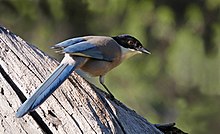Iberian magpie
| Iberian magpie | |
|---|---|

| |
| In Parque natural de la Sierra de Andújar, Spain | |
| Scientific classification | |
| Domain: | Eukaryota |
| Kingdom: | Animalia |
| Phylum: | Chordata |
| Class: | Aves |
| Order: | Passeriformes |
| Family: | Corvidae |
| Genus: | Cyanopica |
| Species: | C. cooki
|
| Binomial name | |
| Cyanopica cooki Bonaparte, 1850
| |
| Synonyms[2] | |
|
Cyanopica cyana cooki | |
The Iberian magpie (Cyanopica cooki) is a bird in the crow family. It is 31–35 cm (12–14 in) long and similar in overall shape to the Eurasian magpie (Pica pica) but is slenderer with proportionately smaller legs and bill. It belongs to the genus Cyanopica.
Taxonomy
The Iberian magpie was
This taxon was formerly treated as
Description
It has a glossy black top to the head and a white throat. The underparts and the back are a light grey-fawn in colour with the wings and the feathers of the long (16–20 cm) tail are an azure blue.
Distribution and habitat
The Iberian magpie occurs in southwestern and central parts of the
Behaviour and ecology
Often Iberian magpies find food as a family group or several groups making flocks of up to 70 birds. The largest groups congregate after the breeding season and throughout the winter months. Their diet consists mainly of acorns (oak seeds) and pine nuts, extensively supplemented by invertebrates and their larvae, soft fruits and berries, and also human-provided scraps in parks and towns.
This species usually nests in loose, open colonies with a single nest in each tree,[14] same mean clutch size is 6.2 eggs, but only 32% of nesting attempts are successful, with an average 5.1 young fledged.[15]
References
- . Retrieved 20 June 2021.
- ^ a b "Cyanopica cooki". Avibase.
- ^ Bonaparte, Charles Lucien (1850). Conspectus Generum Avium (in Latin). Vol. 1. Leiden: E.J. Brill. p. 382.
- ^ Gould, John (1837). The Birds of Europe. Vol. 3: Insessores. London: Published by the author. Plate 217 text.
- ^ a b Mayr, Ernst; Greenway, James C. Jr, eds. (1962). Check-List of Birds of the World. Vol. 15. Cambridge, Massachusetts: Museum of Comparative Zoology. p. 244.
- ISBN 978-1-4081-2501-4.
- ^ Witherby, Harry Forbes (1923). "Cyanopica cyanus gili, subsp. nov". Bulletin of the British Ornithologists' Club. 43: 74.
- ^ Gill, Frank; Donsker, David; Rasmussen, Pamela, eds. (December 2023). "Crows, mudnesters, birds-of-paradise". IOC World Bird List Version 14.2. International Ornithologists' Union. Retrieved 6 February 2024.
- ^ a b Handbook of the Birds of the World vol 12. p. 598.
- PMID 12204127.
- .
- ^ "Iberian Magpie". oiseaux-birds.
- ^ "Gazze aliazzurre in Lombardia". YouTube.
- .
- .

